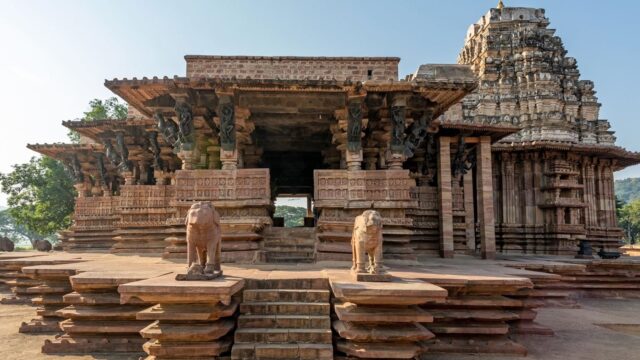
The central government focused on three main parameters for presenting the case of the eight-century old Ramappa temple for nomination to Unesco status.
1. The temple being built on a sand foundation.
2. The construction of the temple with floating bricks.
3. The stones used in the construction of the temple still retaining their original colour.
Everyone should know the history behind the Kakatiyan icon Ramappa temple. The temple is a historical temple built by the Kakatiya kings who ruled over Orugallu. It is close to a village called Palampeta, that is 70 km away from the Kakatiyan capital city of Warangal. It is also called as Ramalingeswara Temple and was a prominent shrine in the erstwhile Kakatiyan kingdom. Now Ramappa is in the new district of Mulugu. It is a classic example of the sculpting prowess of Vishwa Brahmana sculptors.
Ramappa lake is right next to this temple. The lake is also from the Kakatiya time and is a water source for thousands of acres of agricultural land. Palampeta is also a historical village that saw a glorious time in the Kakatiyan rule between 13-14 centuries.
According to the rock inscription that the Kakatiya king Ganapati Deva installed in the temple, Recharla Rudraiah got this temple built in 1213 AD. What is noteworthy is that this medieval temple of Shiva was named not after the presiding deity but after the chief sculptor who built it. It is called Ramalingeswara temple also, combining the name of Shiva to the name of the sculptor. The chief deity in the temple is Ramalingeswara, an incarnation of Vishnu as Rama and Shiva.
This temple is in the distinct style of Kakatiyas, in a star shape on a high pedestal. It faces east, is on a high platform, and has the sanctum sanctorum and entrances on all three sides with a vast Maha Mandapa. In the sanctum sanctorum, there is a huge Shiva Linga in smooth black stone on a high pedestal. In the Maha Mandapa, there are pillars and stone beams that have intricate and elaborate carvings from the Ramayana and Puranas. The beautifully sculpted figurines of Madanika and Nagini on the ceiling of the external edges of the Maha Mandapa are classic examples of the wonderful taste of the Kakatiya kings in art and sculpture. In the temple courtyard, other constructions such as the Nandi Mandapam, Kameswara and Kateswara temples are also worth visiting.
The sculpture in the temple indicates the typical style of the Kakatiyan era. The temple has been built with very light bricks. It is said that the bricks are so light that they float on the water. The Nandi statue in front of the temple has a specialty. It has an interesting posture with a foot raised a little and ears alert as if it is waiting for its master to command it to move. Whichever direction we look at it, it looks as if the Nandi is looking at us. There are also magnificent carvings on the pillars in the Mandapam opposite to the Sanctum Sanctorum. There are two shrines for Shiva. The Nandi statue that is gazing at Shiva still retains its original beauty and condition.
The sculpture and art in Ramappa temple are beautiful beyond words. The rich sculpture of the Kakatiyas still enthralls the visitors even after centuries have passed. It is as if Bharata natyam has been frozen in stone on the pillars and ceilings of the temple. The statues in the temple, especially those of the dancers in black stone on the four corners of the temple Mandapam are stunning. Their graceful postures and the detailed carving of jewellery are mesmerizing to say the least. The pillars in the temple also have carving of dancers and different musical instruments. The extensive carvings of dancers described in the Nrutta Ratnavali written by Jayapa Senani are all established in marvelous stone sculpture in Rama Temple.
It is indeed a matter of pride not just for the people of Telangana but also the entire nation that an incredibly wonderful structure such as the Ramappa Temple got the prestigious Unesco World Heritage Site status.
English Translation: Usha T
Telugu Original: P Balaji Rao















